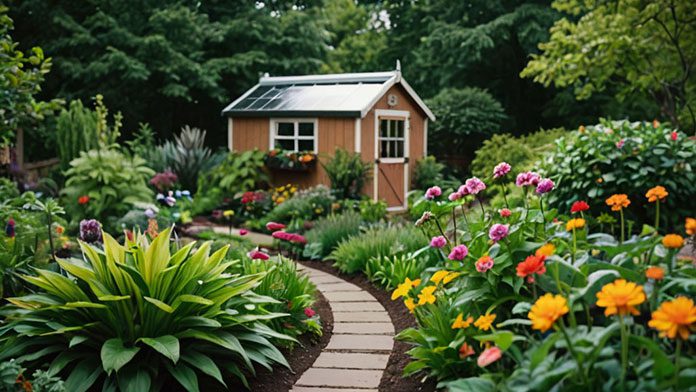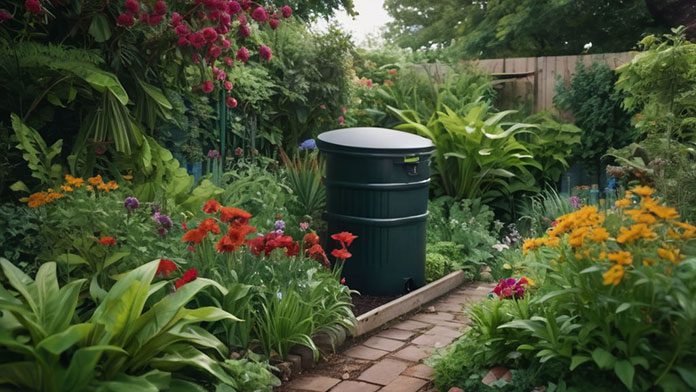Did you know that every year, the average American produces about 4.4 pounds of waste per day?
It’s time to take action and improve our environmental well-being.
In this article, we will explore eight essential tips to help you make a positive impact on the environment.
From reducing waste and conserving energy to supporting local food sources and advocating for environmental policies, these tips will empower you to make a difference and create a sustainable future.
Table of Contents

Related Video: "How the Environment Affects Our Health" by Centers for Disease Control and Prevention (CDC)
Main Points
– Opt for sustainable and organic products to reduce strain on natural resources.
– Practice waste reduction and recycling efforts to minimize waste generation and conserve resources.
– Conserve energy and water usage through smart home technology, energy-efficient appliances, and water-saving techniques.
– Promote sustainable transportation by biking, walking, carpooling, and supporting local and organic food sources to reduce carbon emissions and protect natural habitats.
Understanding the Impact of Individual Choices

You should understand how your individual choices impact the environment. Individual behavior and lifestyle choices play a significant role in shaping the health of our planet. Every decision you make, from the products you purchase to the way you dispose of waste, has a direct impact on the environment.
One of the key areas where individual choices can make a difference is in consumption habits. The products you choose to buy and use can have a substantial environmental footprint. Opting for environmentally friendly options, such as sustainable and organic products, can reduce the strain on natural resources and minimize pollution.
Another area where individual behavior makes a difference is in energy consumption. Simple actions like turning off lights when not in use, using energy-efficient appliances, and reducing water consumption can all contribute to a greener future. By making conscious choices in your daily life, you can help conserve energy and reduce greenhouse gas emissions.
Furthermore, waste management is a critical aspect of individual choices. Proper recycling and responsible disposal of waste can prevent pollution and conserve resources. By practicing sustainable waste management, you can contribute to a cleaner environment and reduce the need for landfill space.
Reducing Waste and Recycling Efforts

By implementing effective waste reduction and recycling strategies, individuals can play a crucial role in promoting environmental well-being. Waste reduction involves minimizing the amount of waste generated, while recycling efforts focus on reusing materials to reduce the demand for new resources. Both strategies are essential for conserving resources, reducing pollution, and mitigating the negative impacts of waste disposal on the environment.
To achieve waste reduction, individuals can adopt practices such as using reusable bags instead of single-use plastic bags, purchasing products with minimal packaging, and opting for digital formats instead of printing documents. Composting initiatives can also significantly contribute to waste reduction by diverting organic waste from landfills and turning it into nutrient-rich compost for gardening. Composting not only reduces the amount of waste sent to landfills but also helps enrich the soil and reduce the need for chemical fertilizers.
Recycling is another crucial aspect of waste management. Individuals can actively participate in recycling programs by sorting and separating recyclable materials such as paper, plastic, glass, and metal. It’s important to follow local recycling guidelines to ensure proper sorting and prevent contamination of recyclables. By recycling, valuable materials can be recovered and reused, conserving natural resources, reducing energy consumption, and preventing the release of harmful chemicals and greenhouse gases during the production of new materials.
Conserving Energy and Water Usage

To conserve energy and water usage, it’s essential to adopt efficient practices in daily routines. By incorporating smart home technology and rainwater harvesting into your lifestyle, you can make significant contributions to environmental conservation. Here are four practical tips to help you in conserving energy and water usage:
1. Install smart home technology: Smart thermostats, lighting systems, and appliances can optimize energy usage by adjusting settings based on your preferences and occupancy. These devices can also provide real-time energy consumption data, allowing you to identify areas where efficiency can be improved.
2. Use energy-efficient appliances: When purchasing new appliances, look for the Energy Star label. These appliances are designed to use less energy without sacrificing performance. Additionally, consider using a dishwasher instead of hand washing, as it consumes less water.
3. Practice water-saving techniques: Simple actions like turning off the faucet while brushing your teeth, fixing leaky faucets promptly, and taking shorter showers can significantly reduce water usage. You can also install low-flow showerheads and faucets to further conserve water.
4. Implement rainwater harvesting: Collecting rainwater from your roof can be used for activities such as watering plants or cleaning outdoor spaces. This reduces the reliance on municipal water sources and contributes to water conservation efforts.
Promoting Sustainable Transportation

To reduce carbon emissions and promote sustainability, consider incorporating eco-friendly transportation options such as biking, walking, or carpooling into your daily commute. These green commuting options not only help reduce your carbon footprint, but also have numerous benefits for your health and the environment.
One effective way to incentivize cycling is by providing dedicated bike lanes and infrastructure. This makes cycling safer and more convenient for commuters, encouraging them to choose this eco-friendly mode of transportation. Additionally, offering bike-sharing programs or subsidies for purchasing bicycles can further encourage people to adopt cycling as a sustainable commuting option.
Walking is another sustainable transportation option that has several advantages. Not only is it emission-free, but it also promotes physical activity, leading to improved health and well-being. Creating pedestrian-friendly infrastructure, such as well-maintained sidewalks and safe crosswalks, can make walking a more attractive choice for daily commuting.
Carpooling is a great way to reduce the number of vehicles on the road, decreasing traffic congestion and carbon emissions. Employers can incentivize carpooling by providing preferential parking spots or offering financial incentives to employees who share rides. Carpooling not only reduces individual transportation costs but also fosters social connections among colleagues.
Supporting Local and Organic Food Sources
By choosing to purchase and consume locally sourced and organic food, you can make a positive impact on both your health and the environment. Supporting local food markets not only ensures that you’re getting the freshest produce available, but it also reduces the carbon footprint associated with transporting food long distances. Organic farming techniques, on the other hand, prioritize the use of natural fertilizers and pest control methods, minimizing the use of synthetic chemicals that can harm the environment and your health.
Here are four reasons why supporting local and organic food sources is beneficial:
1. Reduced environmental impact: Local food markets promote shorter supply chains, resulting in reduced greenhouse gas emissions from transportation. Additionally, organic farming techniques protect soil health, conserve water, and support biodiversity.
2. Fresher and more nutritious food: Locally sourced food is typically harvested at its peak ripeness, ensuring higher nutrient content and better flavor. Organic farming practices also eliminate the use of genetically modified organisms (GMOs) and synthetic pesticides, which can have negative effects on human health.
3. Support for local economies: By purchasing from local farmers and food producers, you’re directly supporting your community’s economy. This helps create jobs, strengthen local food systems, and foster a sense of community.
4. Preservation of farmland and rural landscapes: By supporting local and organic food sources, you contribute to the preservation of farmland and rural landscapes. This is important for maintaining biodiversity, protecting wildlife habitats, and preserving the cultural heritage tied to agriculture.
Protecting and Restoring Natural Habitats
Protecting and restoring natural habitats is crucial for maintaining ecological balance and promoting environmental well-being.
Conserving endangered ecosystems is essential to prevent the loss of unique species and their habitats.
Enhancing biodiversity through restoration efforts can help revive ecosystems and promote the health of natural habitats.
It’s important to strike a balance between urban development and preserving natural areas to ensure the long-term sustainability of our planet.
Conserving Endangered Ecosystems
If you want to contribute to the conservation of endangered ecosystems, start by understanding the importance of protecting and restoring natural habitats. Endangered ecosystems, such as coral reefs and rainforests, are crucial for global biodiversity and provide numerous ecosystem services. Here are four essential tips to help conserve these precious habitats:
1. Restoring Coral Reefs: Participate in coral reef restoration programs that aim to rebuild damaged reefs using innovative techniques like coral gardening and artificial structures.
2. Preserving Rainforests: Support organizations working on rainforest conservation by donating or volunteering. Choose sustainable products to reduce deforestation and promote the preservation of these vital ecosystems.
3. Educating Others: Raise awareness about the value of endangered ecosystems and the threats they face. Encourage others to take action and make sustainable choices in their daily lives.
4. Advocacy and Policy: Engage in advocacy efforts by supporting policies that prioritize the protection and restoration of endangered ecosystems. Write to your elected representatives and express your concerns about the need for conservation measures.
Enhancing Biodiversity Through Restoration
To enhance biodiversity, you can contribute by restoring and protecting natural habitats. Restoring ecosystems plays a crucial role in biodiversity conservation, as it helps to recreate the complex interactions between different species and their environment. By restoring degraded habitats, such as forests, wetlands, or grasslands, you provide a safe haven for a wide range of plants and animals. This leads to increased biodiversity, as native species can thrive and create a balanced ecosystem.
To illustrate the importance of restoring and protecting natural habitats, consider the following table:
| Ecosystem Type | Threats | Restoration Actions |
|---|---|---|
| Forests | Deforestation, habitat loss | Reforestation, habitat restoration |
| Wetlands | Drainage, pollution | Wetland restoration, water quality improvement |
| Grasslands | Conversion to agriculture, overgrazing | Grassland restoration, species reintroduction |
Balancing Urban Development
By incorporating green spaces into urban planning, you can promote the preservation and restoration of natural habitats. Here are four ways in which urban planning can balance development while protecting and restoring these habitats:
1. Designating green corridors: Create interconnected networks of green spaces such as parks, gardens, and urban forests to provide habitats for wildlife and promote biodiversity.
2. Implementing green infrastructure: Integrate nature-based solutions like green roofs, rain gardens, and permeable pavements into urban design to mitigate the negative impacts of urbanization on natural habitats.
3. Restoring degraded areas: Identify and restore degraded or abandoned lands within urban areas, converting them into green spaces that support native plant and animal species.
4. Conserving existing natural areas: Identify and protect existing natural areas within or near urban environments, such as wetlands or woodlands, to safeguard their biodiversity and ecological functions.
Advocating for Environmental Policies and Regulations
When advocating for environmental policies and regulations, you can make a significant impact on the well-being of our planet.
One way to advocate for a greener future is by promoting renewable energy sources. Renewable energy, such as solar and wind power, can significantly reduce greenhouse gas emissions and decrease our dependence on fossil fuels. By advocating for the implementation of policies that support the development and use of renewable energy, you’re contributing to the mitigation of climate change and the preservation of our natural resources.
Another area where you can make a difference is by advocating for policies that promote green building practices. Green buildings are designed to be energy-efficient, water-efficient, and environmentally friendly throughout their entire life cycle. They utilize sustainable materials, reduce waste, and have a minimal impact on the environment. By supporting and promoting policies that encourage the construction of green buildings, you’re contributing to the reduction of carbon emissions and the conservation of resources.
Advocating for environmental policies and regulations is crucial in ensuring a sustainable future. By actively participating in the development and implementation of such policies, you’re playing a vital role in protecting our planet’s ecosystem and securing a better future for generations to come.
Educating and Engaging Others in Environmental Conservation
To effectively educate and engage others in environmental conservation, there are several strategies that can be employed:
1. Organize interactive workshops: Interactive workshops provide hands-on learning experiences for participants. These workshops allow individuals to actively engage with environmental issues and learn practical solutions. By providing a space for discussion and exploration, workshops can create a deeper understanding of the importance of environmental conservation.
2. Utilize social media campaigns: Social media is a powerful tool for reaching a wider audience. By utilizing platforms such as Facebook, Instagram, and Twitter, organizations can raise awareness about the importance of environmental conservation. Social media campaigns can include informative posts, engaging videos, and interactive quizzes to educate and engage followers.
3. Coordinate community clean-up events: Organizing community clean-up events not only helps in cleaning up the environment but also fosters a sense of community and collective responsibility towards environmental well-being. These events bring people together to actively contribute to the improvement of their surroundings. By working together, communities can make a tangible impact on their local environment.
Interactive Workshops for Education
Host interactive workshops to actively involve and educate others in environmental conservation. These workshops are an effective way to engage participants and provide them with valuable knowledge and skills to contribute to the protection of the environment.
Here are four key benefits of hosting interactive workshops for education:
1. Increased awareness: Interactive workshops allow participants to actively engage in discussions, activities, and simulations, which enhance their understanding of environmental issues and their impact on the planet.
2. Practical learning: Through hands-on activities and demonstrations, participants can learn practical strategies and techniques for sustainable living and conservation practices.
3. Collaboration and networking: Workshops provide opportunities for individuals with similar interests to come together, share ideas, and collaborate on environmental projects, fostering a sense of community and collective action.
4. Motivation and empowerment: Interactive workshops can inspire and empower participants by providing them with the knowledge, tools, and resources to make positive changes in their own lives and communities.
Social Media Campaigns
You should regularly and actively engage with others through social media campaigns to educate and promote environmental conservation.
Social media strategies play a crucial role in online activism and can be an effective tool for spreading awareness about environmental issues. By leveraging the power of social media platforms, you can reach a wide audience and inspire them to take action.
When designing your social media campaigns, it’s important to focus on creating engaging and shareable content. Utilize visually appealing graphics, compelling videos, and impactful stories to grab the attention of your audience.
Additionally, encourage active participation and interaction by organizing contests, quizzes, and challenges related to environmental conservation.
Community Clean-Up Events
Get involved in local community clean-up events to actively educate and engage others in environmental conservation. Volunteer participation in these events can have a significant impact on increasing environmental awareness within the community. Here are four reasons why community clean-up events are essential for improving environmental well-being:
1. Hands-on learning: Participating in clean-up events allows individuals to witness firsthand the impact of pollution on their environment. This experiential learning can deepen their understanding of the need for environmental conservation.
2. Building a sense of community: Community clean-up events bring people together, fostering a sense of unity and shared responsibility for the environment. Working together towards a common goal strengthens community bonds and encourages long-term environmental stewardship.
3. Raising awareness: By actively participating in clean-up events, volunteers become advocates for environmental conservation. They can share their experiences with others, spreading the message of the importance of protecting our planet.
- Creating lasting change: Community clean-up events not only clean up the immediate environment but also inspire lasting change. Through education and engagement, these events empower individuals to make sustainable choices in their daily lives, contributing to a greener and healthier future.
Frequently Asked Questions
How Can I Calculate My Carbon Footprint and Understand the Impact of My Individual Choices on the Environment?
To calculate your carbon footprint and understand the impact of your choices on the environment, there are various tools and resources available. These can help you measure your emissions and identify areas where you can make sustainable changes.
What Are Some Innovative and Easy Ways to Reduce Waste and Increase Recycling Efforts in My Daily Life?
To reduce waste and increase recycling efforts in your daily life, consider innovative upcycling techniques and getting involved in community composting. These actions can have a significant impact on the environment and contribute to a more sustainable future.
How Can I Conserve Energy and Water Usage at Home to Contribute to Environmental Well-Being?
To conserve energy and water at home, use energy-saving appliances and install water-efficient plumbing. These measures not only contribute to environmental well-being but also help reduce utility bills and promote sustainable living.
What Are Some Sustainable Transportation Options That I Can Adopt to Reduce My Carbon Emissions?
To reduce your carbon emissions, consider eco-friendly commuting options such as public transportation. Utilizing buses, trains, or subways can significantly decrease your environmental impact, contributing to a more sustainable future.


